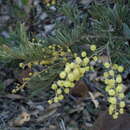tr
kırıntılardaki isimler


Acacia fulva, known colloquially as velvet wattle or soft wattle, is a species of Acacia native to eastern Australia.[1]
Acacia fulva grows as a shrub or tree, ranging anywhere from 1.5 to 15 m in height. Young trees have smooth grey-green bark, which darkens and becomes rough and fissured with age. New growth is covered in red-brown velvety hairs.[2] The silver-grey leaves are pinnate, with 4-12 pairs of pinnae, each 3-7.5 cm long. Each pinna in turn is made up of 11 to 28 pairs of 3–10 mm-long pinnules. Flowering occurs from November till June, the yellow flowerheads arranged in axillary and terminal panicles or racemes. Each small round flower head is composed of 20 to 40 individual flowers. Flowering is followed by the development of the 2–12 cm-long leathery seed pods,[1] which are ripe between April and November.[3]
Specimens of Acacia fulva were previously assigned to the species A. mollifolia until Mary Tindale described it as a separate species in 1966.[2] Queensland botanist Les Pedley reclassified the species as Racosperma fulvum in 2003 amongst debate over the best way to deal with Acacia sensu lato's polyphyletic definition.[4] When the dust settled, Acacia had been restricted to Australian species, returning A. fulva to its original name.
It is found on soils derived from sandstone and basalt that are high in nutrients. It grows in woodland, associated with such species as forest red gum (Eucalyptus tereticornis), grey box (E. moluccana), and narrow-leaved ironbark (E. crebra), and shrubs such as dogwood (Jacksonia scoparia), Exocarpus, Clerodendrum, Clematis and Senecio.[3]
Acacia fulva, known colloquially as velvet wattle or soft wattle, is a species of Acacia native to eastern Australia.
Acacia fulva grows as a shrub or tree, ranging anywhere from 1.5 to 15 m in height. Young trees have smooth grey-green bark, which darkens and becomes rough and fissured with age. New growth is covered in red-brown velvety hairs. The silver-grey leaves are pinnate, with 4-12 pairs of pinnae, each 3-7.5 cm long. Each pinna in turn is made up of 11 to 28 pairs of 3–10 mm-long pinnules. Flowering occurs from November till June, the yellow flowerheads arranged in axillary and terminal panicles or racemes. Each small round flower head is composed of 20 to 40 individual flowers. Flowering is followed by the development of the 2–12 cm-long leathery seed pods, which are ripe between April and November.
Specimens of Acacia fulva were previously assigned to the species A. mollifolia until Mary Tindale described it as a separate species in 1966. Queensland botanist Les Pedley reclassified the species as Racosperma fulvum in 2003 amongst debate over the best way to deal with Acacia sensu lato's polyphyletic definition. When the dust settled, Acacia had been restricted to Australian species, returning A. fulva to its original name.
It is found on soils derived from sandstone and basalt that are high in nutrients. It grows in woodland, associated with such species as forest red gum (Eucalyptus tereticornis), grey box (E. moluccana), and narrow-leaved ironbark (E. crebra), and shrubs such as dogwood (Jacksonia scoparia), Exocarpus, Clerodendrum, Clematis and Senecio.
Acacia fulva est une espèce du genre Acacia, famille des Mimosaceae.
Acacia fulva se développe comme un arbuste ou un arbre, allant de 1,5 à 15 mètres de hauteur. Les jeunes arbres ont une écorce lisse gris-vert, qui s'assombrit et devient rugueuse et fissurée avec l'âge. La nouvelle croissance est couverte de poils veloutés brun-rouge [1]. Les feuilles gris argent sont pennées, avec 4 à 12 paires de pinnules, chacune de 3 à 7,5 centimètres de long. Chaque pinna est à son tour composé de 11 à 28 paires de pinnules de 3 à 10 millimètres de long. La floraison a lieu de novembre à juin, les capitules jaunes sont disposés en panicules ou racèmes axillaires et terminaux. Chaque petite fleur ronde est composée de 20 à 40 fleurs individuelles. La floraison est suivie par le développement des gousses coriaces de 2 à 12 cm de long[2], mûres entre avril et novembre.
Acacia fulva est présent dans l'est de l'Australie[2]. On le trouve sur les sols dérivés du grès et du basalte riches en nutriments. Il pousse en forêt, associé à des espèces telles que Eucalyptus tereticornis, Eucalyptus moluccana et Eucalyptus crebra, et des arbustes comme Jacksonia scoparia ou des genres Exocarpos, Clerodendrum, Clematis et Senecio.
Acacia fulva est une espèce du genre Acacia, famille des Mimosaceae.
Acacia fulva é uma espécie de leguminosa do gênero Acacia, pertencente à família Fabaceae.[1]
Acacia fulva é uma espécie de leguminosa do gênero Acacia, pertencente à família Fabaceae.
Acacia fulva là một loài thực vật có hoa trong họ Đậu. Loài này được Tindale miêu tả khoa học đầu tiên.[1]
Acacia fulva là một loài thực vật có hoa trong họ Đậu. Loài này được Tindale miêu tả khoa học đầu tiên.